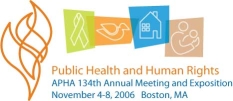 Back to Annual Meeting
|

|
 Back to Annual Meeting
|
APHA Scientific Session and Event Listing |
 Back to Annual Meeting
|

|
 Back to Annual Meeting
|
APHA Scientific Session and Event Listing |
Eric R. Kessell, MPH, School of Public Health, Division of Epidemiology, University of California-Berkeley, 2727 Mariposa St. Suite 100, San Francisco, CA 94110, 415-577-5893, ekessell@berkeley.edu, Jennifer A. Alvidrez, PhD, Department of Psychiatry, University of California-San Francisco, 2727 Mariposa St. Suite 100, San Francisco, CA 94110, and William McConnell, PhD, Community Behavioral Health Services, San Francisco Department of Public Health, 1380 Howard Street, San Francisco, CA 94103.
Introduction: Blacks may be more likely than other groups to hold negative views of police and of mental health treatment, and may be therefore less likely to contact the police to deal with psychiatric crises. We would thus expect fewer mental-health (MH) related calls to the police to come from predominantly black neighborhoods relative to other neighborhoods. Methods: We classified approximately 3,050,000 records to identify all community-initiated 911 calls to the San Francisco Police Department (SFPD) over 34 months as being MH or non-MH and calculated the proportion of MH calls in each of 49 SFPD sectors. We geoprocessed various demographic and housing indicators from 2000 Census data to identify community-level predictors of the proportion of MH calls across districts. We also generated maps of the outcome and predictors of interest. Results: Median proportion of MH calls across police sectors was 2.1%. Bivariate linear regressions indicated that regions with a higher proportion of Black residents had a lower proportion of MH calls (β= -0.027, p<0.05). However, this association was no longer significant (β= -0.011, p<0.326) in multivariate models that included proportion of male residents and rented housing units, total number of calls, and median resident age. Discussion: Contrary to our hypothesis, racial composition of neighborhoods was not associated with the proportion of MH calls after controlling for other neighborhood characteristics. Rather, more MH calls originated in sectors presumed to have a higher prevalence of severe mental illness, such as districts characterized by single adult males living alone and residential instability.
Learning Objectives:
Keywords: African American, Crime
Presenting author's disclosure statement:
Not Answered
The 134th Annual Meeting & Exposition (November 4-8, 2006) of APHA